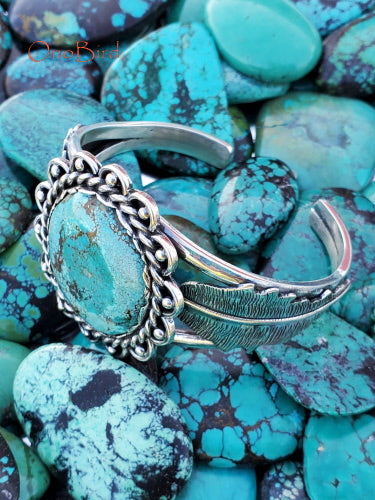Spiritual and Esthetic Power Behind Turquoise Jewelry’s Popularity

Spiritual and Esthetic Power Behind Turquoise Jewelry’s Popularity
If you ask someone to describe a shade between green and blue, what color word are they most likely to use? Chances are, they'd use the word "turquoise". While some linguists might argue over the origin of the word, none can deny that the term came from the stone, not the other way around.
Why has this blueish, greenish stone captured our imaginations for eons? Let's take a closer look at the historical, spiritual, and esthetic value of turquoise jewelry through the ages.
What Is Turquoise?
Before we dig into the history, spiritual value, and other traits of turquoise, we must first discuss what turquoise is. Turquoise is a mineral composed of aggregated, hydrated copper and aluminum phosphate. The copper content is the source of the gem's greenish hue.
It's most often found as a vein or deposit in other host rocks, rather than as separate pieces. That's why most genuine pieces of turquoise these days are found in mines, as they need to be chipped away from the host rock.
The History of Turquoise Jewelry
Turquoise jewelry has a long and somewhat troubled history. The word we use for the stone and the color it contains comes from the French word for "Turkish". This is most likely due to Turkey being France's first exposure to this gorgeous semiprecious stone. However, turquoise the gem has been in use since ancient times.
Pockets of turquoise use have been found in a variety of ancient civilizations. Archeologists and Egyptologists have found ancient pharaohs adorned with turquoise jewelry in their tombs. Over in China, artisans have carved talismans and jewelry from turquoise for over three thousand years. Turquoise is even Tibet's national stone, in keeping with its long history.
Turquoise was also used by Native American cultures in Mesoamerica and the United States Southwest in talismans, jewelry, and as a trading token. This is part of the reason why turquoise often shows up in southwestern jewelry.
The Spiritual Value of Turquoise
Turquoise, as befitting its ancient origins, is a gem with a great deal of spiritual meaning. The exact magickal or spiritual properties of turquoise will vary depending on which culture you ask. However, most cultures seem to agree that it has powerful healing properties and can serve as a cleanser for the body, mind, and spirit.
This also means that turquoise has powerful protective properties. Modern crystal healers and other magickal/spiritual practitioners will use it to protect a space or ritual from negative energies. Since turquoise is also connected with the throat chakra, many people prize using it in charming necklaces to heal physical issues with the throat or improve communication with others.
For those who are into astrology, turquoise is the birthstone associated with the sign Sagittarius. It's also one of the stones primarily associated with the month of December. So, if you're looking for a birthday gift for the December baby in your life, a turquoise charm would be a perfect choice!
The Esthetic Value of Turquoise
More than its historical or spiritual value, turquoise continues its popularity to this day due to its sheer beauty. Many people become entranced by this stone's unique color and veins. Each piece of turquoise is different from the other. Even pieces of turquoise that came from the same deposit in the same mine can look completely different!
Turquoise makes for a perfect business-casual accessory. Depending on its fittings and the other elements of the accessory, it can be an eye-catching casual bohemian piece or a stunning vintage brooch. From necklaces to bolo ties to bracelets, you can find a turquoise accessory for every occasion.
More Shades Than Middling Blue-Green
While turquoise is most famously known for its greenish, blueish hue, you can find many more shades in nature than those alone. Depending on where they were mined, you can find pieces of turquoise with a deep blue color or yellow-green tone. The deepest blue color is considered the rarest of all shades.
Since turquoise comes from host stones, it often has matrices from those stones. These matrices and veins can appear brown, ochre, or black. Iranian turquoise tends to have fewer matrices and a deeper blue hue, while American turquoise tends greener and almost always has them.
Designers tend to avoid greener specimens of this gem, as it can be harder to pair with other shades. However, those unafraid to work with shades of green will seek these less-desired stones out.
Understanding the Types of Natural Turquoise
There are a wide variety of natural turquoise stones available for artisans and jewelers. These stones tend to be named for their source mine or ore deposit. Some of the most common types used by jewelers and fashion designers alike include:
Ajax Turquoise
Ajax turquoise comes from the Ajax Mine in the Candelaria Hills of Esmeralda, Nevada. This variety of turquoise is most commonly known for its gorgeous blue-green, bi-color stones. Stones from this mine can run from deep moss green to baby blue within centimeters. As such, it's one of the holy grails for the true collector.
Carico Lake Turquoise
Carico Lake turquoise is one of the many varieties that are green rather than blue. These pastel green stones often have light brown matrices. These pale pieces make for elegant ring and brooch settings.
Cerrillos Turquoise
The Cerrillos Mine has been in use for centuries. Located around ten miles from Santa Fe, this mine's turquoise occupies a special place in Southwestern Native American history.
The stones from this mine run the entire spectrum of turquoise. However, it's most well known for its brown-matrixed, forest green stone.
Golden Hills Turquoise
Golden Hills turquoise is among the paler, more elegant varieties that you can find. These stones come from Kazakhstan's Golden Hills. They are a soft, feminine shade of baby blue with lavender overtones. The matrices for these stones can range from reds to browns to deep lavender shades.
Royston Turquoise
Royston turquoise comes from (surprise) the Royston mining area around Tonopah, Nebraska. It's the most stunning, unforgettable shade of turquoise available. It melds bright blues, greens, and browns into mesmerizing skyscapes and nebulas.
Sleeping Beauty Turquoise
Sleeping Beauty turquoise comes from the (now, alas, no longer in operation) Sleeping Beauty Mine in Globe, Arizona. Curiously, it lacks one of the things that makes turquoise most famous. Sleeping Beauty turquoise is most well-known for its clarity and the absence of turquoise's usual veins.
These stones are a deep, clear blue shade. Since the mine which produced them is no longer active, it's become more valuable (and expensive) for its scarcity.
Enhanced, Stabilized, and Reconstructed Turquoise
While natural turquoise is preferable to the alternatives, it can prove unstable in its natural state. Thus, there are three varieties of turquoise that can grant greater stability at the expense of its 'raw' value. These varieties are enhanced, stabilized, and reconstructed. Here are the differences between them:
Enhanced Turquoise
The sole difference between enhanced and natural turquoise is that enhanced turquoise has undergone a chemical treatment process. This treatment process, known as Zachery, bathes the turquoise in minerals identical to those in the natural substance and a charged electrical current.
Enhanced turquoise has decreased porosity and intensified color. It's also much harder than the natural version.
Stabilized Turquoise
Stabilized turquoise is the most common variety you'll find in jewelry and talismans on the market. Extracted natural turquoise can often be unstable in its original state. Stabilization, or adding epoxy to low-grade turquoise via high pressure, intensifies the color and hardens the stone, just like enhancing does.
Part of the reason this variety of turquoise is more common than enhanced is that high and low-grade stones can be used in the process.
Reconstructed Turquoise
Reconstructed turquoise is, without a doubt, the most fake-feeling of the varieties you can buy. It takes ground down turquoise powder and mixes it with epoxy and other plastics to create blocks and stones. Due to its high plastic content, it feels cheap and fake compared to the real thing. However, some designers prefer to use this variety due to its "perfection" compared to other options.
Dyed "Turquoise"
Some canny artists and jewelers have found a way to skimp on the cost of getting real turquoise by dying a soft mineral known as howlite. You can usually tell a stone is fake by its cheaper price tag or a simple scratch test. Turquoise may be a soft mineral, but howlite is even softer.
Reviewing the Traits and Values of Turquoise
Turquoise is a stone with thousands upon thousands of years of history. As such, turquoise jewelry occupies a special place in our consciousness and culture. No matter how many ages may pass, we will continue to adore this blue-green stone and all its beauty.
If you want to take your place in history with your own pair of turquoise earrings, we at Onobird are happy to assist you. Our artisans have crafted a wide variety of jewelry pieces that can go with any outfit that you have. Browse our wares today and find the perfect piece for you!

Leave a comment